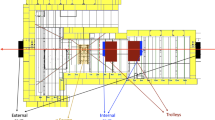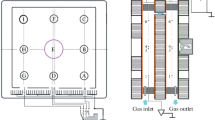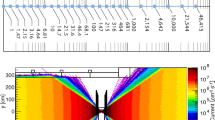Abstract
Resistive Plate Chambers (RPC) are gasesous detectors employed at CERN LHC experiments thanks to their trigger performance, timing capabilities and contained production costs. High Pressure Laminate RPCs are operated with a three-component gas mixture, made of 90–95% of C\(_2\)H\(_2\)F\(_4\), around 5% of i-C\(_4\)H\(_{10}\) and 0.3% of SF\(_6\). Due to the presence of leaks at detector level and to the greenhouse characteristics of C\(_2\)H\(_2\)F\(_4\) and SF\(_6\), RPCs in ATLAS and CMS were accounting for about 87% of CO\(_2\) equivalent emissions during LHC Run 2. To address this, several alternative gases were studied, including R-1234ze as a possible substitute for R-134a. Furthermore, the addition of some amount of CO\(_2\) into the RPCs gas mixture was explored as a possible short-to-medium term solution to lower the total greenhouse gas emissions and reduce the usage of C\(_2\)H\(_2\)F\(_4\). A dedicated data taking campaign was performed at the Gamma Irradiation Facility at CERN, where RPCs detectors performance were studied with muon beam and gamma background. The detectors were operated with the addition of 30% and 40% and 50% of CO\(_2\) to the standard gas mixture, together with an increased fraction of SF\(_6\). Two different amounts of i-C4H10 were also evaluated to assess compatibility with the CMS and ATLAS requirements. Results from these beam tests with the above-mentioned gas mixtures are reported in this work.
Similar content being viewed by others
Avoid common mistakes on your manuscript.
1 Introduction
Resistive Plate Chambers (RPC) detectors are gaseous detectors [1] extensively utilized in CERN LHC experiments due to their remarkable muon detection capabilities and cost-effective production. High Pressure Laminate (HPL) RPCs can be found in the muon systems of the ALICE, ATLAS, and CMS experiments. These RPCs are operated with a gas mixture composed of 90–95% C\(_2\)H\(_2\)F\(_4\) (R-134a), 4.5–10% i-C\(_4\)H\(_{10}\), 0.3% SF\(_6\), and 7000–8000 ppm water vapor. Both R-134a and SF\(_6\) are recognized greenhouse gases, with global warming potentials (GWP) of 1430 and 22800, respectively [2], and a combined gas mixture GWP of around 1490.
To decrease Greenhouse Gas (GHG) consumption and emissions in accordance with European strategies aimed at reducing the usage of high-GWP fluorinated gases [3], CERN has explored various approaches. One primary research direction concentrates on investigating alternative gases for use in particle detectors.
Given that during LHC Run 2 RPCs were responsible for approximately 87% of GHG emissions of gaseous particle detector due to leakage at the detector level, it is crucial to find an alternative gas mixture that could decrease or replace R-134a consumption.
When seeking an alternative gas mixture, multiple criteria must be satisfied for compatibility with existing LHC RPC systems: The gas mixture should be non-flammableFootnote 1 and not considered toxic for safety purposes. The detector’s operating point must not surpass the maximum voltage permitted by the high voltage system, and the charge generated in the gap should be sufficient for detection by the currently installed front-end electronics. Moreover, in anticipation of High-Luminosity LHC (HL-LHC), the gas mixture should not negatively impact the detectors’ rate capability. As a result, RPCs should operate with the minimum possible number of streamers.
2 Experimental Setup
Experiments were carried out using three High Pressure Laminate (HPL) RPCs, each featuring a 2 mm electrode thickness and a 2 mm gas gap. These RPCs measured \(70\,\text {cm} \times 100\,\text {cm}\), and the electrode resistivity, determined through plasma Argon measurements [4], was found to be 1–\(5 \times 10^{10} \Omega \) cm. Each RPC was outfitted with seven \(2.5\,\text {cm} \times 100\,\text {cm}\) copper strips for reading induced signals.
The detectors were positioned at CERN’s Prevessin site within the Gamma Irradiation Facility (GIF++) [5]. Here, a \({}^{137}\)Cs gamma source emulates LHC background conditions, while a muon beam is occasionally provided to test the detectors’ muon detection performance. A set of two scintillators installed in the bunker, in addition with an external trigger provided by the GIF++ facility, was used to trigger on muon beam particles. A CAEN V1730 digitizer was employed to read the signal induced on the strip, recording raw waveforms to enable pulse shape analysis and the evaluation of critical RPC parameters, such as efficiency, prompt charge, cluster size, time resolution, and signal duration (Fig. 1).
Muon efficiency was calculated by setting a 2 mV height threshold on the raw signal, which corresponds to a minimum charge threshold of 40 fC. From there, the working point was determined by fitting the efficiency-voltage curve with a sigmoid function and taking 95% of the maximum efficiency + 150 V. The resulting working point was found to be around 9600–9800 V, which is consistent with the values currently employed in the ATLAS and CMS experiments [6, 7]. A prompt charge threshold of 10\(^{8}\) electrons, akin to Raether’s limit [8], was used to classify signals either avalanches or streamers.
The cluster size was computed as the maximum count of neighboring firing strips for a given trigger acquisition. Time resolution was estimated by calculating the time difference between the external trigger’s falling edge and the muon signal’s arrival time. Time over threshold was defined as the time between the first and last sample recorded above the efficiency threshold. The parameters mentioned above were calculated for various gas mixtures and under different background conditions, ranging from only a muon beam to a gamma hit rate of around 600 Hz/cm\(^2\).
3 Alternative gases to R-134a and SF\(_6\)
R-134a is extensively used in the refrigerant industry due to its thermal properties. This industry has developed environmentally friendly alternatives, such as R-1234ze, which belongs to the Hydro-Fluoro-Olefins (HFO) family. With a GWP lower than 7 and low toxicity, R-1234ze is considered to be suitable for LHC operation. SF\(_6\) is commonly employed as an insulator in high-voltage plants because of its dielectric properties. Possible SF\(_6\) alternatives can be found in the family of perfluorinated ketones, such as C\(_4\)F\(_8\)O, C\(_6\)F\(_{12}\)O, C\(_5\)F\(_{10}\)O, fluoronitrile C\(_4\)F\(_7\)N (commercially known as Novec™4710), or chlorinated HFOs like Amolea™1224yd [9].
4 Performance of RPCs operated with eco-friendly gases in LHC-like conditions
As described in Chapter 2, the detectors were studied with only muon beam (Source Off condition) and at different background conditions, up to a gamma hit rate of 500–600 Hz/cm\(^2\), which reflects the expected background hit rate of RPCs for the High-Luminosity LHC phase [10].
4.1 HFO-based gas mixtures
In this study, the CMS RPC gas mixture, denoted as the standard gas mixture, served as a baseline for comparing the performance of various gas mixtures across different RPC gaps. Two R-1234ze-based gas mixtures were investigated: a mixture of 22.25/22.25/50/4.5/1 R-134a/R-1234ze/CO\(_2\)/i-C\(_4\)H\(_{10}\)/SF\(_6\) called HFO + 50% CO\(_2\), and another mixture of 32.45/32.45/30/4.5/0.6 R-134a/R-1234ze/He/i-C\(_4\)H\(_{10}\)/SF\(_6\) named HFO + 30% He. These two gas mixtures have GWPs of 890 and 903, respectively, indicating a potential reduction of around 55% in CO\(_2\) emissions.
Figure 2 displays the efficiency and streamer probability curves for an RPC operated with HFO + 50% CO\(_2\) and HFO + 30% He, using only a muon beam. Both the He and CO\(_2\) based gas mixtures exhibit a higher working point (defined as \(\text {HV}_{95\% \epsilon _{\textrm{max}}} + 150\) V) than the standard mixture, with the He gas mixture being closer to the standard gas mixture. The streamer probability was evaluated the working point and it is reported in Fig. 2 as an empty marker in red. It can be observed that both R-1234ze gas mixtures present about 7–8% more streamer signals compared to the standard gas mixture. The gas mixture with helium demonstrates about 1.5% fewer streamers than the CO\(_2\) mixture.
Figure 3 illustrates the detector current density values, assessed at the working point, for various background conditions. For each gas mixture, the current density data was fitted with a linear function. It can be observed that the standard gas mixture exhibits the lowest current increase, while the R-1234ze and CO\(_2\) gas mixture demonstrates the highest ones. Specifically, when evaluating currents at 500 Hz/cm\(^2\), the R-1234ze/He mixture shows an increase of approximately 40%, whereas the R-1234ze/CO\(_2\) mixture presents an increase of 60% compared to the standard gas mixture’s currents. Despite the He-based gas mixture showed overall better performance, the usage of He was discarded due to the current leaks from RPC detectors and the presence of Photo Multiplier Tubes in LHC experimental caverns.
4.2 Addition of CO\(_2\) to the standard gas mixture
Carbon dioxide (CO\(_2\)) was added to the standard gas mixture in concentrations of 30%, 40%, and 50%, by reducing the equivalent amount of R-134a. Figure 4 shows that in the prompt charge distribution at the detector’s working point there is an increasing amount of streamers with a median charge of about 50–60 pC. The streamer population increases with higher CO\(_2\) concentrations. One hypothesis to explain the higher amount of streamers could is that the lower amount of R-134a which has a higher electron attachment coefficient with respect to CO\(_2\) decreases the amount of free electrons collisions with gas molecules. Additionally, Fig. 4 reveals the emergence of two populations in the region [0.8–2] pC. The origin of these signals is under investigation.
In examining signal durations, a significant increase in mean time over threshold was observed as CO\(_2\) concentrations increased. Figure 5 demonstrates that with concentrations exceeding 30% CO\(_2\), the time over threshold surpasses 25 ns, corresponding to the LHC bunch crossing time.
To suppress streamers and reduce the likelihood of after pulses, several tests were conducted by increasing the amount of SF\(_6\) in gas mixtures with 30%, 40%, and 50% CO\(_2\). In particular, for each 50% CO\(_2\) concentration, 0.3%, 0.6%, and 0.9% of SF\(_6\) were tested, by reducing the equivalent amount of R-134a. Performance improvements were evaluated by calculating the difference between the working point and the voltage at which the streamer fraction reaches 10% for each gas mixture. Figure 6 shows that the standard gas mixture exhibits the largest separation, indicating streamer-free operation. Adding more SF\(_6\) increases the separation, although with 50% CO\(_2\), the separation is consistently negative, indicating a significant presence of streamers.
Higher concentrations of SF\(_6\) were tested during a different beam period and with a different detector. Results are shown in Fig. 7. A 1% concentration of SF\(_6\) with 30% CO\(_2\) exhibited the highest separation, while 1%, 1.5%, and 2% SF\(_6\) showed progressively higher separations but consistently lower than the gas mixture with 30% CO\(_2\).
The gas mixture containing 30% CO\(_2\) and 1% SF\(_6\) was compared with 4.5% and 5% of i-C4H10 to assess the possibility of using the gas mixture in both the CMS and ATLAS experiments. Figure 8 displays the efficiency and streamer probability curves for the two gas mixtures. Both show a working point slightly lower than the standard gas mixture and are not significantly different from each other. Additionally, the streamer fraction is similar between the two gas mixtures, suggesting that i-C4H10 does not significantly affect muon beam performance in the short term.
The chosen gas mixtures were assessed under varying gamma source intensity levels. The highest irradiation tested was approximately 600 Hz/cm\(^2\), which corresponds to the maximum hit rate anticipated for the High Luminosity LHC (HL-LHC) on the CMS endcap RPCs, taking into account a safety factor of 3 [10].
Figure 9 presents the decline in maximum efficiency attained by the detector as it relates to the rate. Up to rates of 500 Hz/cm\(^2\), no substantial differences were observed, but a 2% discrepancy becomes noticeable as the detector approaches 500 Hz/cm\(^2\).
As shown in Fig. 10, when evaluating background currents in relation to the gamma hit rate, the two CO\(_2\)-based gas mixtures exhibited a roughly 20% increase in currents compared to the standard gas mixture. A possible explanation is given by the large amount of SF\(_6\) which captures free electrons and contributes to the development of a larger ionic charge. Nonetheless, no significant difference was detected between the gas mixtures containing 4.5% and 5% of i-C\(_4\)H\(_{10}\), implying that the charge developed per gamma hit for the two mixtures is comparable.
Time resolution and cluster size were found to be stable under different background conditions. The CO\(_2\)-based gas mixtures exhibited similar or slightly lower time resolution in comparison to the standard gas mixture, while the cluster size appeared to be marginally larger, albeit within the measurement error. The time over threshold was also measured using only the muon beam. The average value obtained at the working point was approximately 11 ns for the standard gas mixture and around 14.5–15 ns for the CO\(_2\)-based gas mixtures, with the two values being consistent with one another.
5 Conclusions
Several alternative gas mixtures were tested to evaluate the possibility of reducing the consumption of R-134a from HPL RPCs at the CERN LHC experiments, with the aim of mitigating GHG emissions from operation at LHC.
Few selected R-1234ze-based gas mixtures made use of the same amount of R-134 and R-1234ze, with He or CO\(_2\) being used to lower the working point of the detector. Results showed that the tested R-1234ze-based gas mixtures have a higher working point than the standard gas mixture. The streamer contamination is around 5 times higher for the tested gas mixtures when compared to the standard R-134a gas mixture. When evaluating the currents of the RPC under intense background conditions, the R-1234ze gas mixtures show an increase of 40% and 60%, depending on whether He or CO\(_2\) is used. More gas mixtures, based on different concentrations of the components or on new gases, may need to be tested to obtain performances closer to the current standard gas mixture.
The addition of CO\(_2\) to the Freon-based gas mixture was identified as a possible short-to-medium solution to mitigate the emissions. RPCs were also tested with lower GWP gas mixtures, including R-1234ze-based mixtures in LHC-like background conditions, using muon beam and gamma background radiation.
CO\(_2\) was added from concentrations of 10% up to 50%, and it was observed that an increase in the overall charge developed within the gap correlated with the increase of CO\(_2\). For this reason, the increase of SF\(_6\) in the gas mixture was studied as a possible solution to suppress streamer formation. Two gas mixtures were ultimately selected: one with 30% of CO\(_2\), 1% SF\(_6\) and 4.5% of i-C\(_4\)H\(_{10}\) and one with the same concentrations but with 5% of i-C\(_4\)H\(_{10}\) to be compatible with the ATLAS RPC system. Both gas mixtures showed similar performance between each other and similar performance with the standard CMS gas mixture, taken as a reference. The gas mixture with 5% of i-C\(_4\)H\(_{10}\) was selected for further tests at the GIF++ where long-term performance will be carefully studied.
Data Availability Statement
This manuscript has associated data in a data repository. [Authors’ comment: Data that supports the findings of this article are available upon request. Please contact the corresponding author for more information].
Notes
The non-flammability requirement is applicable to the ATLAS and CMS RPC systems but not to the ALICE MID system.
References
R. Santonico, R. Cardarelli, Development of resistive plate counters. Nuclear Instrum. Methods Phys. Res. 187(2), 377–380 (1981). https://doi.org/10.1016/0029-554X(81)90363-3
S. Solomon, The physical science basis: contribution of working group i to the fourth assessment report of the intergovernmental panel on climate change. Intergovernmental Panel on Climate Change (IPCC), Climate change 2007, vol. 996 (2007)
M. Schulz, D. Kourkoulas, Regulation (EU) no 517/2014 of the European parliament and of the council of 16 April 2014 on fluorinated greenhouse gases and repealing regulation (EC) no 842/2006. Off. J. Eur. Union 2014(517), 150 (2014)
M. Abbrescia, V. Peskov, P. Fonte, Basics of Resistive Plate Chambers (Wiley, New York, 2018), pp. 45–110 Chap. 3. https://doi.org/10.1002/9783527698691.ch3
M.R. Jakel, M. Capeans, Efthymiopoulos, I., Fabich, A., Guida, A., Maire, G., Moll, M., Pfeiffer, D., Ravotti, F., Reithler, H.: CERN GIF++: a new irradiation facility to test large-area particle detectors for the high-luminosity LHC program. PoS TIPP2014, 102 (2014)
J.G. Layter, The CMS Muon Project: Technical Design Report. Technical design report. CMS. CERN, Geneva (1997). https://cds.cern.ch/record/343814
A. Collaboration, ATLAS Muon Spectrometer: Technical Design Report. Technical design report. ATLAS. CERN, Geneva (1997). https://cds.cern.ch/record/331068
H. Raether, Electron Avalanches and Breakdown in Gases (Butterworths, New York, 1964)
R. Guida, B. Mandelli, G. Rigoletti, Studies on alternative eco-friendly gas mixtures and development of gas recuperation plant for RPC detectors, in Nuclear Instruments and Methods in Physics Research Section A: Accelerators, Spectrometers, Detectors and Associated Equipment vol. 1039, p. 167045 (2022) https://doi.org/10.1016/j.nima.2022.167045
C. Collaboration, The Phase-2 Upgrade of the CMS Muon Detectors. Technical report, CERN, Geneva. This is the final version, approved by the LHCC. (Sep 2017) https://cds.cern.ch/record/2283189
Funding
Open access funding provided by CERN (European Organization for Nuclear Research).
Author information
Authors and Affiliations
Corresponding author
Rights and permissions
Open Access This article is licensed under a Creative Commons Attribution 4.0 International License, which permits use, sharing, adaptation, distribution and reproduction in any medium or format, as long as you give appropriate credit to the original author(s) and the source, provide a link to the Creative Commons licence, and indicate if changes were made. The images or other third party material in this article are included in the article's Creative Commons licence, unless indicated otherwise in a credit line to the material. If material is not included in the article's Creative Commons licence and your intended use is not permitted by statutory regulation or exceeds the permitted use, you will need to obtain permission directly from the copyright holder. To view a copy of this licence, visit http://creativecommons.org/licenses/by/4.0/.
About this article
Cite this article
Rigoletti, G., Guida, R. & Mandelli, B. Studies on RPC detectors operated with environmentally friendly gas mixtures in LHC-like conditions. Eur. Phys. J. Plus 138, 841 (2023). https://doi.org/10.1140/epjp/s13360-023-04434-y
Received:
Accepted:
Published:
DOI: https://doi.org/10.1140/epjp/s13360-023-04434-y














